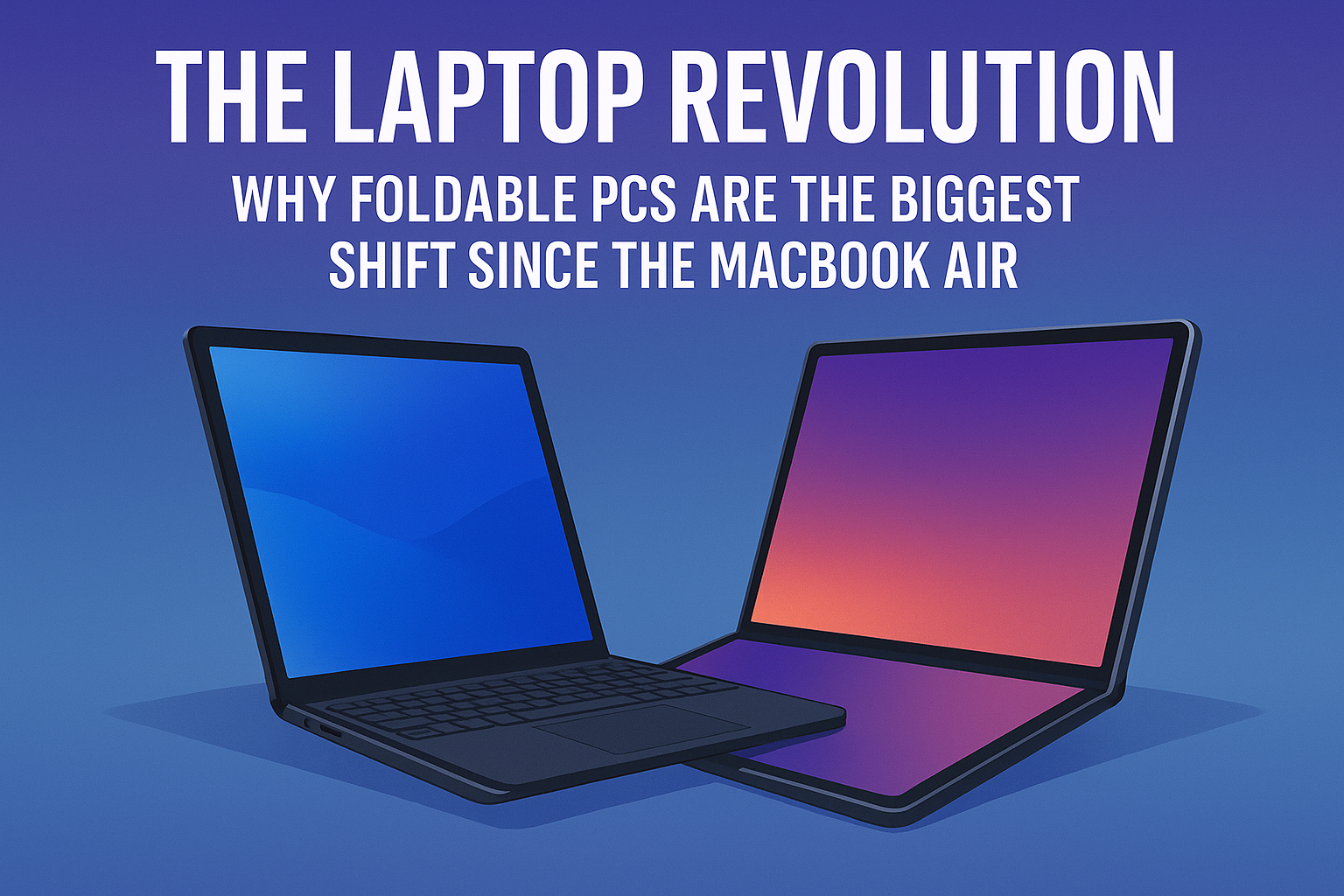Introduction
In 2008, Apple unveiled the MacBook Air, a machine so slim and portable that it redefined what consumers expected from laptops. Seventeen years later, in 2025, the industry may be witnessing its next major leap: foldable laptops. With devices like the Lenovo ThinkPad X1 Fold, Asus Zenbook Fold, and experimental models from Samsung and Microsoft, foldable PCs are no longer science fiction—they’re a consumer reality.
But is this the dawn of a true revolution in personal computing, or just another niche experiment? Let’s dive deep into the tech, usability, and future potential of foldable laptops.
1. The Technology Behind Foldable Laptops
At the heart of foldable PCs are flexible OLED displays, a technology refined over a decade of foldable smartphones. These displays allow laptops to function both as single-screen tablets and as dual-screen workstations when folded.
-
Hinge mechanics: The durability of the hinge is crucial. Manufacturers now boast hinges tested for 30,000–50,000 folds, equating to years of daily use.
-
Battery distribution: Foldables often split their batteries across two halves, maintaining balance and weight distribution.
-
Software optimization: Windows 11 and ChromeOS now include native dual-screen modes, automatically adjusting apps to the fold.
This isn’t just about bending screens—it’s a fundamental redesign of the laptop form factor.
2. Productivity Potential: A New Kind of Workstation
Imagine a laptop that can transform into three different devices:
-
Tablet mode – a 17-inch touch display when unfolded flat.
-
Laptop mode – with a virtual or detachable keyboard.
-
Dual-screen mode – where the lower half becomes a secondary display for multitasking.
For writers, coders, and analysts, this flexibility means:
-
Running Slack or Teams on one half, while working on documents on the other.
-
Using the bottom half for chatGPT, notes, or research, while the top half shows the main project.
-
Creative apps like Photoshop, Blender, and Premiere Pro taking advantage of extended screen real estate.
It’s a mobile workstation dream—if the hardware can keep up.
3. Gaming and Creative Workflows
One major question: Can foldables handle gaming and creative workloads?
-
Gaming: Early foldables use integrated GPUs or mid-tier discrete GPUs. While not replacements for gaming rigs, they run esports titles like Valorant, Fortnite, and League of Legends smoothly. High-end AAA games still push limits, though cloud gaming (GeForce Now, Xbox Cloud) fills the gap.
-
Creative apps: For video editors, foldables excel in timeline management—with tools on one half and preview windows on the other. Artists love the pen support for sketching on a massive canvas.
The verdict? Foldables shine in productivity and creativity, but gaming enthusiasts may want dedicated hardware.
4. The Price Problem
Like all bleeding-edge tech, foldable PCs come at a cost:
-
Lenovo ThinkPad X1 Fold (2024): $2,499
-
Asus Zenbook Fold (2025): $2,799
-
Samsung Galaxy Book Fold (rumored 2025): Expected $2,000–$2,500
These prices place foldables firmly in the premium tier, limiting mainstream adoption. For comparison, ultrabooks like the MacBook Air M3 or Dell XPS 13 start at around $1,099.
The key question is: Will prices drop quickly enough to make foldables mainstream? If foldable phones are any guide, costs could fall within 3–5 years.
5. Durability Concerns: Lessons from Foldable Phones
Early adopters of foldable smartphones remember the Galaxy Fold (2019) fiasco, where hinges cracked and dust seeped in. Today, laptops face the same scrutiny:
-
Hinge strength is better, but foldable screens still crease.
-
Keyboard integration remains awkward, with some models relying on detachable Bluetooth keyboards.
-
Longevity of flexible OLEDs over 3–5 years is still unproven.
Consumers buying a $2,500 machine expect it to last a decade. Until foldables prove themselves, skepticism remains.
6. Who Are Foldable Laptops For?
The audience for foldables in 2025 looks like this:
-
Early adopters & tech enthusiasts – those who bought foldable phones in 2019.
-
Professionals & creatives – designers, video editors, and 3D artists who benefit from large displays.
-
Frequent travelers – who want the portability of a laptop with the screen size of a desktop monitor.
For the average student or office worker? A MacBook Air or Dell XPS still offers better value.
7. Future Outlook: Mainstream by 2030?
Industry analysts believe foldables could follow the smartphone curve:
-
2019–2022: Expensive, experimental.
-
2023–2026: Better durability, growing ecosystem.
-
2027–2030: Mass adoption as prices fall and software catches up.
By 2030, foldables may replace traditional laptops in certain markets, especially creative industries and hybrid workspaces.
But one big wildcard remains: Apple. If Apple launches a foldable MacBook or iPad hybrid, adoption could skyrocket overnight.
Conclusion
Foldable laptops aren’t just a gimmick. They represent the biggest rethinking of laptops since the MacBook Air made portability the gold standard. While high prices and durability concerns limit their appeal today, the technology has real potential.
The bottom line: In 2025, foldable PCs are a luxury for early adopters, but by 2030, they could be the default laptop form factor.
